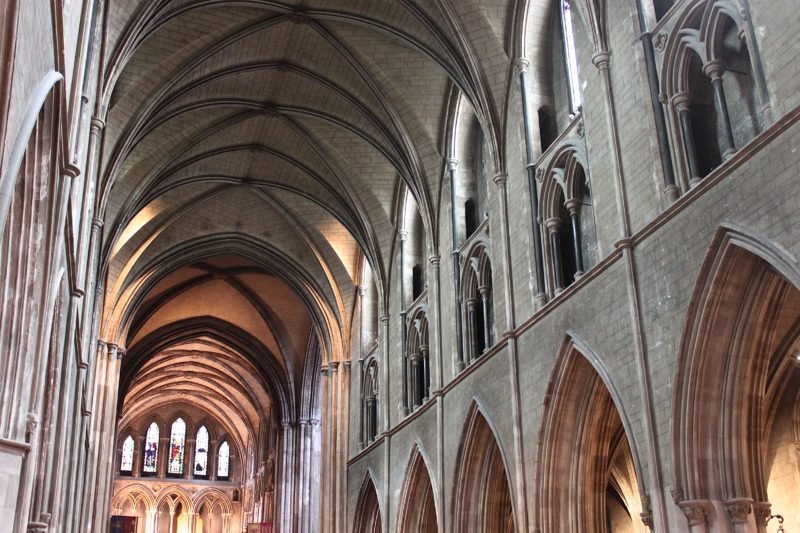DUBLIN MUST SEES
As both the capital and largest city of Ireland, people flock to Dublin to take in all of the culture that is offered from the many pubs, shops, sights, galleries, museums, restaurants, and more. Dublin was founded by Vikings during the 9th century and named Dubh Linn (Black Pool) for the lake where the Danes first anchored their boats. The port was cemented as a key maritime centre, and Dublin flourished for many centuries. Things began to decline in the 20th century, which led to war and ultimately the establishment of the Republic of Ireland. More recently, an economic boom known as the “Celtic Tiger” ushered in massive expansion and development to the city. There is charm and hidden gems around every corner, but if you’ve never been to Dublin, here are a few sights you cannot miss:
Trinity College Dublin & The Long Room
Trinity College Dublin, the University of Dublin, is Ireland’s highest ranked university. Established by royal charter in 1592 and home to 17,000 undergraduate and postgraduate students, its campus resides in the heart of Dublin’s city centre. Some famous students who I love and admire are Oscar Wilde and Bram Stoker. While wandering around this absolutely gorgeous campus, do not forget to tour the Long Room of The Old Library at Trinity College. The Long Room is nearly 65 metres in length and filled with 200,000 of the Library’s oldest books. Marble busts of philosophers and writers connected to Trinity College Dublin line the Long Room, a collection that started in 1743. One particular artifact in the room that I found to be really special is the Brian Boru harp, one of the oldest harps of its kind in Ireland, dating back to the 14th or 15th century. You might recognize it as the model for the emblem of Ireland! Trinity College is not to be missed, and I encourage you to get tickets in advance to see the Long Room.
The Long Room of The Old Library at Trinity College
St. Patrick’s Cathedral
The present St. Patrick’s Cathedral in terms of shape and size, dates from 1220 – 1259, replacing an earlier church. It was built on the site of an ancient well, which is said to have been used by Saint Patrick himself to baptize people into Christianity. Archbishop John Comyn was responsible for obtaining Saint Patrick’s Cathedral status, while Archbishop Luke (who held the position from 1219 to 1260) made the construction possible. I saw a small sign at St. Patrick’s Cathedral, which mentioned the reason for the Gothic architecture, was so people would turn their faces upward to God, and I thought that was really beautiful. It is clear that the devotion to walking a righteous path is reflected in all of the hard work it took to both make and keep up with the restoration of the cathedral. St. Patrick’s is open to the public every day, just check the website for specific hours!
inside St. Patrick’s Cathedral
St. Stephen’s Green
If you want to forget you are in a metropolis for a bit, head to St. Stephen’s Green! The park is named after a church called St. Stephen’s in that area in the 13th century. At first, the park was open to the public but after much deterioration, St. Stephen’s Green was restored and then turned into a private park only accessible by those who rented keys to the park. In 1877, Sir Arthur Guinness (later known as Lord Ardilaun), bought the green, redesigned the park, and reopened St. Stephen’s Green in 1880 to the citizens of Dublin (to their delight!) The Park has won the Green Flag Award every year since 2015, which promotes the highest standards in parks and green spaces. Please be aware that there are a TON of seagulls that inhabit the park.
St. Stephen’s Green
Dublin Castle
Dublin Castle was erected in the early 13th century on the site of a Viking settlement. (If you purchase tickets to take a tour of the castle, you actually get to see stones from the original stronghold in Powder Tower and a set of steps that leads down to the original moat!) For centuries, Dublin Castle served as headquarters of English, and later British, administration in Ireland. However, once Ireland became independent in 1922, Dublin Castle was relinquished to the new Irish government. Today, it is a government complex as well as a wonderful place to visit! My favorite part of our visit was seeing the Chapel Royal on site. Dublin Castle has had a chapel on its grounds since at least 1242, but the present chapel was designed by Francis Johnston and was opened in 1814. Now deconsecrated, its stained glass windows and intricate carvings are worth seeing.
outside the Royal Chapel of Dublin Castle



